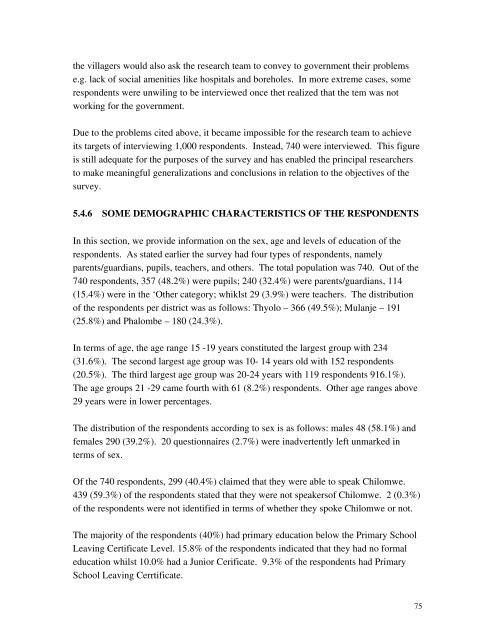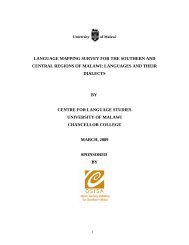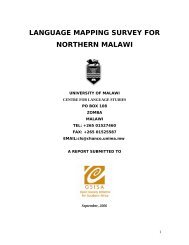SOCIOLOLINGUISTIC SURVEYS - Centre for Language Studies
SOCIOLOLINGUISTIC SURVEYS - Centre for Language Studies
SOCIOLOLINGUISTIC SURVEYS - Centre for Language Studies
You also want an ePaper? Increase the reach of your titles
YUMPU automatically turns print PDFs into web optimized ePapers that Google loves.
the villagers would also ask the research team to convey to government their problems<br />
e.g. lack of social amenities like hospitals and boreholes. In more extreme cases, some<br />
respondents were unwiling to be interviewed once thet realized that the tem was not<br />
working <strong>for</strong> the government.<br />
Due to the problems cited above, it became impossible <strong>for</strong> the research team to achieve<br />
its targets of interviewing 1,000 respondents. Instead, 740 were interviewed. This figure<br />
is still adequate <strong>for</strong> the purposes of the survey and has enabled the principal researchers<br />
to make meaningful generalizations and conclusions in relation to the objectives of the<br />
survey.<br />
5.4.6 SOME DEMOGRAPHIC CHARACTERISTICS OF THE RESPONDENTS<br />
In this section, we provide in<strong>for</strong>mation on the sex, age and levels of education of the<br />
respondents. As stated earlier the survey had four types of respondents, namely<br />
parents/guardians, pupils, teachers, and others. The total population was 740. Out of the<br />
740 respondents, 357 (48.2%) were pupils; 240 (32.4%) were parents/guardians, 114<br />
(15.4%) were in the ‘Other category; whiklst 29 (3.9%) were teachers. The distribution<br />
of the respondents per district was as follows: Thyolo – 366 (49.5%); Mulanje – 191<br />
(25.8%) and Phalombe – 180 (24.3%).<br />
In terms of age, the age range 15 19 years constituted the largest group with 234<br />
(31.6%). The second largest age group was 10 14 years old with 152 respondents<br />
(20.5%). The third largest age group was 2024 years with 119 respondents 916.1%).<br />
The age groups 21 29 came fourth with 61 (8.2%) respondents. Other age ranges above<br />
29 years were in lower percentages.<br />
The distribution of the respondents according to sex is as follows: males 48 (58.1%) and<br />
females 290 (39.2%). 20 questionnaires (2.7%) were inadvertently left unmarked in<br />
terms of sex.<br />
Of the 740 respondents, 299 (40.4%) claimed that they were able to speak Chilomwe.<br />
439 (59.3%) of the respondents stated that they were not speakersof Chilomwe. 2 (0.3%)<br />
of the respondents were not identified in terms of whether they spoke Chilomwe or not.<br />
The majority of the respondents (40%) had primary education below the Primary School<br />
Leaving Certificate Level. 15.8% of the respondents indicated that they had no <strong>for</strong>mal<br />
education whilst 10.0% had a Junior Cerificate. 9.3% of the respondents had Primary<br />
School Leaving Cerrtificate.<br />
75





